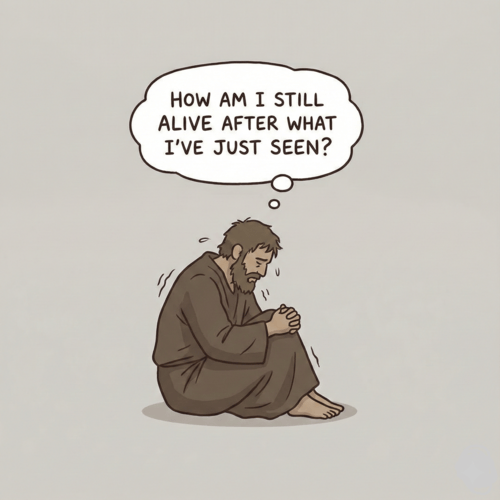‘Pray With Holy Hands Lifted Up’: What Does Paul Mean?
Picture this: you’re in a worship service where some people raise their hands while others keep them folded. Both groups wonder if they’re doing it “right.” Meanwhile, Paul’s actual instruction in 1 Timothy 2:8 gets lost in our debates about posture. When the apostle writes, “Therefore I want the men everywhere to pray, lifting up holy hands, without wrath and doubting,” is he really prescribing a prayer position—or teaching us something far more profound?
The answer reveals everything about how we approach God In prayer.
‘PRAY WITH HOLY HANDS LIFTED UP’: THE CONTEXT
Paul doesn’t drop this instruction randomly. The “therefore” in verse 8 connects directly to his preceding argument about God’s universal desire for salvation and Christ’s mediation for all people. Paul has just established prayer should be offered “for all people—for kings and all those in authority” because God “wants all people to be saved.”
Now comes his conclusion: since God desires universal prayer for universal salvation, the men leading these prayers must be spiritually qualified. Paul isn’t thinking about arm positions—he’s thinking about heart positions.
The historical context reinforces this. Ephesus, where Timothy was based, was plagued by conflicts that were disrupting worship. Arguments and divisions were making their prayers ineffective. Paul’s remedy wasn’t choreography; it was character reformation.
“HOLY HANDS” POINT TO HEART PURITY
Here’s where Reformed theology’s commitment to Scripture interpreting Scripture becomes crucial. When Paul emphasises “holy hands,” he’s drawing from a rich Old Testament tradition that has nothing to do with physical posture.
The psalmist asks, “Who may ascend the mountain of the LORD? Who may stand in his holy place?” The answer: “The one who has clean hands and a pure heart” (Psalm 24:3-4). Notice the pairing—clean hands represent moral purity, not raised hands.
Isaiah drives this point home when God declares, “When you spread out your hands in prayer, I hide my eyes from you; even when you offer many prayers, I am not listening. Your hands are full of blood!” (Isaiah 1:15). God’s concern isn’t the spreading; it’s the spiritual contamination that renders prayer ineffective.
Paul follows this biblical pattern. The word “holy” modifies “hands”—that’s where his emphasis falls. In Greek, this construction highlights the condition of the hands, not their elevation. Paul wants hands that are set apart from sin, consecrated for approaching God.
Consider Paul’s broader theology: “Physical training is of some value, but godliness has value for all things” (1 Timothy 4:8). If external posture were his priority here, it would contradict his consistent emphasis that God looks at the heart, not outward appearance.
‘PRAY WITH HOLY HANDS LIFTED UP’: THE REVEALING QUALIFIERS
Paul’s additional requirements—“without wrath and doubting”—expose his real agenda. These aren’t instructions on posture; they’re spiritual prerequisites.
“Without wrath” directly addresses the Ephesian conflicts disrupting their prayers. This connects to Jesus’ teaching: “If you are offering your gift at the altar and there remember that your brother or sister has something against you, leave your gift there in front of the altar. First go and be reconciled to them; then come and offer your gift” (Matthew 5:23-24).
James reinforces this: “Human anger does not produce the righteousness that God desires” (James 1:20). Angry prayers aren’t just ineffective—they’re contradictory to God’s nature.
“Without doubting” points to faith as prayer’s foundation. James warns that doubters shouldn’t “expect to receive anything from the Lord” (James 1:7). Paul wants men whose faith enables them to approach God’s throne with confidence, not hesitation.
These qualifiers reveal Paul’s true concern: the spiritual condition that makes prayer powerful, not the physical position that makes it look proper.
WHY POSTURE MISSES THE POINT
If Paul primarily cared about raised hands, several questions arise: Why specify only men? Why not detail other physical requirements like kneeling or facing directions? Why wasn’t this a universal command for all prayer?
The answer is simple: Paul assumed his readers knew about common prayer postures. Ancient prayers often included raised hands—this wasn’t revolutionary instruction. Paul’s innovation was adding “holy” as the crucial qualifier.
This aligns perfectly with Reformed hermeneutics. When Jesus said, “God is spirit, and his worshipers must worship in Spirit and in truth” (John 4:24), He emphasised spiritual reality over physical form. Paul follows this same principle.
THE HEART OF TRUE PRAYER
Paul’s instruction transforms how we approach prayer. Before raising our hands—literally or figuratively—we must examine our hearts. Are we harbouring anger that needs resolution? Are we nurturing doubts that need addressing? Are our hands “holy”—set apart from known sin and consecrated for God’s service?
This doesn’t forbid physical expressions of worship. Reformed theology celebrates freedom in non-essential matters. Some may pray with raised hands, others with folded hands, still others while walking. The posture isn’t Paul’s point—the purity is.
Corporate worship leaders especially need this perspective. Churches need men who model heart holiness, not perfect choreography. The goal isn’t synchronised gestures but sanctified spirits.
CLEAN HANDS, PURE HEARTS
Paul commands holy character, not holy choreography. He directs us past external performance to internal transformation. The hands that effectively approach God’s throne aren’t those positioned perfectly—they’re those purified completely.
Before your next prayer, don’t check your posture. Check your heart. God desires “holy hands”—hands clean from sin and lifted in faith, whatever their physical position.
That’s what Paul means.
‘PRAY WITH HOLY HANDS LIFTED UP’: RELATED FAQs
What did John Calvin specifically say about “lifted hands” in 1 Timothy 2:8? Calvin emphasised Paul’s instruction focuses on the spiritual condition rather than physical gesture. In his commentary, Calvin argues “holy hands” refers to hands “free from all violence, fraud, and rapine”—essentially moral purity. He notes that while the ancients commonly prayed with raised hands, Paul’s innovation was adding the qualifier “holy,” making spiritual preparation the essential requirement for effective prayer.
- Why does Paul specifically address “men” (Greek: andras) rather than all believers? Reformed scholars like John MacArthur argue Paul addresses men specifically because they were the designated prayer leaders in public worship settings. The Greek word andras refers to adult males, not humanity in general (anthropos). This instruction targets those leading corporate prayer, where conflicts and anger would be particularly disruptive to the congregation’s worship and witness.
- What is the Greek grammatical significance of “lifting up holy hands”? The Greek construction epairō hosios cheir places the emphasis on the adjective “holy” (hosios) rather than the verb “lifting” (epairō). Reformed commentators note hosios specifically denotes ceremonial or ritual purity—being set apart for sacred purposes. The participial phrase “lifting up” functions more as a cultural assumption than a commanded posture, while “holy” carries the theological weight of Paul’s instruction.
How do contemporary Reformed scholars handle the cultural aspects of raised hands? Modern Reformed theologians like RC Sproul and Sinclair Ferguson acknowledge raised hands were the normative prayer posture in ancient Jewish and Greco-Roman culture. They argue Paul isn’t introducing new choreography but assumes existing practice while adding spiritual requirements. The cultural ubiquity of raised hands in prayer actually supports the Reformed interpretation—Paul’s focus falls on the moral qualification “holy,” not the familiar gesture.
- What connection exists between “holy hands” and Old Testament temple worship? Reformed scholars draw parallels to Levitical purity requirements, where priests had to ceremonially wash their hands before approaching God’s altar (Exodus 30:17-21). However, they emphasize that Paul spiritualizes this concept—New Testament believers need moral cleansing from sin rather than ritual washing. The “holy hands” represent the heart condition necessary for New Covenant prayer, where all believers function as priests before God.
- How does this passage relate to Paul’s teaching about “doubtful disputations” in Romans 14? Reformed theologians see consistency in Paul’s approach to worship practices across his letters. Just as Romans 14 focuses on heart attitudes rather than external observances in matters of food and days, 1 Timothy 2:8 prioritizes spiritual preparation over physical posture in prayer. Both passages reflect Paul’s principle that God examines the heart, not outward performance, in worship matters where Scripture doesn’t provide explicit commands.
Do Reformed scholars see any connection to Jesus’ teaching about prayer posture? Yes, Reformed commentators frequently connect this passage to Jesus’ encounter with the Samaritan woman in John 4:20-24, where Jesus declares that true worshipers worship “in spirit and truth” rather than in specific locations or postures. They also reference Jesus’ parable of the Pharisee and tax collector (Luke 18:9-14), where the tax collector’s humble posture accompanied genuine repentance, while the Pharisee’s proper stance masked spiritual pride—demonstrating that heart condition, not physical position, determines prayer’s effectiveness.
‘PRAY WITH HOLY HANDS LIFTED UP’: OUR RELATED POSTS
Editor's Pick

The Throne-Room Vision: Who Did Isaiah See?
The scene is unforgettable: Isaiah stands in the temple, and suddenly the veil between heaven and earth tears open. He [...]

The Angel of the Lord: Can We Be Certain It Was Christ All Along?
Throughout the Old Testament, a mysterious figure appears: the Angel of the LORD. He speaks as God, bears God’s name, [...]
SUPPORT US:
Feel the Holy Spirit's gentle nudge to partner with us?
Donate Online:
Account Name: TRUTHS TO DIE FOR FOUNDATION
Account Number: 10243565459
Bank IFSC: IDFB0043391
Bank Name: IDFC FIRST BANK






